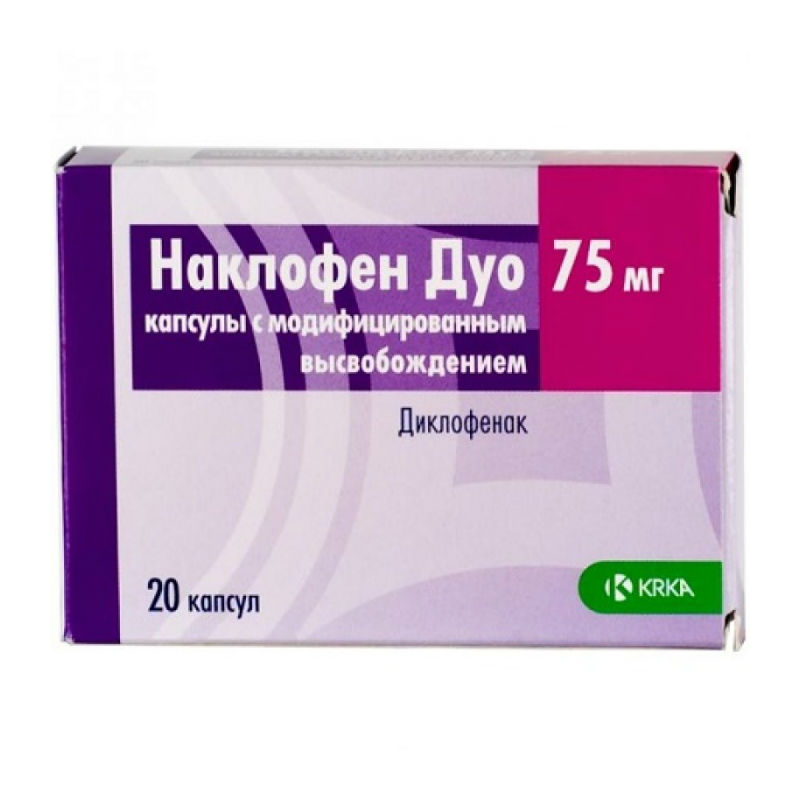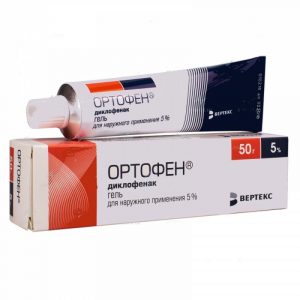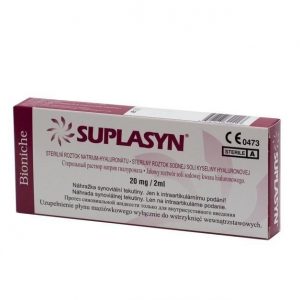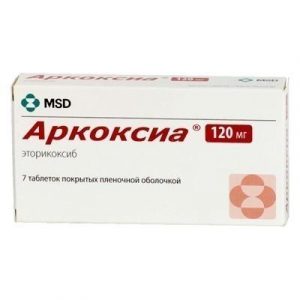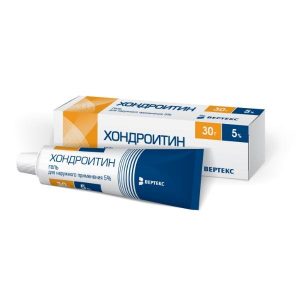Description
Release form
modified-release capsules
Packing
20 pcs.
Indications
– inflammatory and degenerative diseases of the musculoskeletal system (rheumatoid arthritis, psoriatic arthritis, juvenile chronic arthritis, ankylosing spondylitis (ankylosing spondylitis), gouty arthritis, arthritis in Reiter’s disease, rheumatic arteriosis of the soft tissue and rheumatic joint disease including with radicular syndrome, tenosynovitis, periarthritis, bursitis, myositis, synovitis)
– pain syndrome of mild or moderate severity (neuralgia, myalgia, lumbar ischalgia, post-traumatic pain syndrome, accompanied by inflammation, postoperative pain, headache, migraine, algodismenorrhea, adnexitis, proctitis, toothache, renal and biliary colic – srdl complex therapy of infectious and inflammatory diseases of the ENT organs with severe pain (pharyngitis, tonsillitis, otitis media)
– febrile syndrome.
The drug Naklofen Duo is intended for symptomatic therapy and does not affect the progression of the disease.
Contraindications
– complete or incomplete combination of bronchial asthma, recurrent polyposis of the nose and paranasal sinuses and intolerance to acetylsalicylic acid and other NSAIDs (including a history of)
– the period after coronary artery bypass grafting
– erosive-ulcerative changes in the gastric mucosa or duodenal ulcer – active gastrointestinal tract intestines in the exacerbation phase (UC, Crohn’s disease)
– cerebrovascular bleeding or other bleeding and hemostatic disorders
– severe liver failure or active bolevanie liver
– severe renal failure (creatinine clearance less than 30 mL / min) in t h confirmed hyperkalemia.,. progressive kidney disease
– decompensated heart failure
– inhibition of bone marrow hematopoiesis
– III trimester of pregnancy
– lactation (breastfeeding)
– childhood (up to 18 years)
– hypersensitivity to diclofenac.
With caution, you should prescribe the drug Naklofen Duo for coronary heart disease, cerebrovascular disease, dyslipidemia / hyperlipidemia, diabetes mellitus, peripheral artery disease, smoking, CC less than 60 ml / min, history of gastrointestinal ulcer, the presence of Helicobacter pylori infection, prolonged use of NSAIDs, frequent alcohol consumption, severe somatic diseases, induced porphyria, epilepsy, diverticulitis, systemic diseases of the connective tissue, a significant reduction in BCC (including after massive surgery), elderly patients (prescribed in lower doses), including receiving diuretics, debilitated patients and patients with low body weight, in the I and II trimesters of pregnancy, with concomitant therapy with the following drugs: anticoagulants (e.g. warfarin), antiplatelet agents (e.g. acetylsalicylic acid, clopidogrel), oral glucocorticoids (e.g. prednisone), selective serotonin reuptake inhibitors (e.g. citalopram, fluoxetine, paroxetine, sertraline).
Special instructions
In order to quickly achieve the desired therapeutic effect, take the drug Naklofen Duo 30 minutes before a meal. In other cases, take before, during or after a meal entirely with a sufficient amount of water.
To reduce the risk of adverse events from the gastrointestinal tract, the minimum effective dose should be used with the lowest possible course.
Use caution with the drug Naklofen Duo for ulcerative colitis and Crohn’s disease due to a possible exacerbation of the disease.
With prolonged use of diclofenac, it is possible, although in rare cases, to develop serious hepatotoxic reactions, in connection with which it is recommended to regularly examine liver function.
Due to the important role of prostaglandins in maintaining renal blood flow, special care should be taken when prescribing the drug to patients with heart or kidney failure, as well as in the treatment of elderly people taking diuretics and patients who, for whatever reason, have a decrease in BCC (for example, after major surgery). If diclofenac is prescribed in such cases, it is recommended that kidney function be monitored as a precaution.
Diclofenac should be prescribed with caution to patients with blood clotting disorders, with porphyria, epilepsy, and also to patients receiving anticoagulants or fibrinolytics.
During long-term therapy, it is necessary to control the picture of peripheral blood, to analyze feces for occult blood.
Due to the negative effect on fertility, women who wish to become pregnant are not recommended to use the drug. In patients with infertility (including those undergoing examination), it is recommended to cancel the drug.
Patients taking the drug should refrain from drinking alcohol.
In infectious diseases, the anti-inflammatory and antipyretic effects of diclofenac sodium can mask the symptoms of these diseases.
The amount of sucrose contained in the preparation does not affect patients with the following conditions: enzyme deficiency of lactase, galactosemia and impaired glucose / galactose absorption syndrome.
Effect on the ability to drive vehicles and control mechanisms
During the treatment period, a decrease in the speed of mental and motor reactions, therefore, it is necessary to refrain from engaging in potentially hazardous activities that require an increased concentration of attention and speed of psychomotor reactions.
Composition
1 caps.: sodium diclofenac 75 mg, including: – diclofenac sodium (in enteric-soluble pellets) 25 mg
– sodium diclofenac (in prolonged-release pellets) 50 mg excipients – Excipients: spheres (sucrose content not more than 92%), hyprolysis (hydroxypropyl cellulose), hypromellose, heavy magnesium carbonate, methacrylic acid and ethyl acrylate copolymer (1: 1) dispersion 30%, triethyl citrate, talc, titanium dioxide, sodium carboxymethyl cellulose, macrogol, sodium hydroxide pellets sustained release – sugar spheres (sucrose content of not more than 92%), the ammonium methacrylate copolymer (type A), the ammonium methacrylate copolymer (type B), giproloza (hydroxypropylcellulose), triethyl citrate, talc.
capsule contents: enteric pellets, sustained release pellets, talc *.
Capsule body composition: gelatin (EP), titanium dioxide (E171).
Composition of capsule cap: gelatin (EP), titanium dioxide (E171), indigo carmine dye FD&C Blue2 (E132).
Dosage and Administration
The drug Naklofen Duo is taken orally. The capsule should be swallowed whole, washed down with water at the end or after a meal, usually in the morning.
Appointed individually, taking into account the severity of the disease. Adults are usually prescribed 75 mg (1 caps.) 1-2 times / day. The maximum daily dose is 150 mg.
Side effects
Often – 1-10% sometimes – 0. 1-1% rarely – 0.01-0.1% very rarely – less than 0.01%, including isolated cases.
From the digestive system: often – epigastric pain, abdominal cramps, nausea, vomiting, diarrhea, dyspepsia, flatulence, anorexia, increased activity of aminotransferases rarely – gastritis, bleeding from the gastrointestinal tract (vomiting with blood, melena, diarrhea mixed with blood), i Gastrointestinal tract (with or without bleeding or perforation), hepatitis, jaundice, impaired liver function very rarely – stomatitis, glossitis, dry mucous membranes (including the mouth), damage to the esophagus, diaphragm-like intestinal strictures (nonspecific hemorrhagic colitis, exacerbations ulcerative colitis or Crohn’s disease), constipation, pancreatitis, fulminant hepatitis.
On the part of the nervous system: often – headache, dizziness rarely – drowsiness very rarely – impaired sensitivity, incl. paresthesia, memory disorders, tremors, convulsions, anxiety, cerebrovascular disorders, aseptic meningitis, disorientation, depression, insomnia, nightmares, irritability, agitation, mental disorders.
On the part of the sensory organs: often – vertigo is very rare – impaired vision (blurred vision, diplopia), hearing impairment, tinnitus, taste impairment.
From the urinary system: very rarely – acute renal failure, hematuria, proteinuria, interstitial nephritis, nephrotic syndrome, papillary necrosis, edema.
From the hemopoietic organs: very rarely – thrombocytopenia, leukopenia, eosinophilia, hemolytic and aplastic anemia, agranulocytosis.
Allergic reactions: anaphylactic / anaphylactoid reactions, including a marked decrease in blood pressure and shock very rarely – angioedema (including the face). The drug contains methyl parahydroxybenzoate and propyl parahydroxybenzoate, which can cause allergic reactions.
From the cardiovascular system: very rarely – palpitations, tachycardia, extrasystole, chest pain, increased blood pressure, vasculitis, heart failure, myocardial infarction.
From the respiratory system: rarely – cough, bronchial asthma (including shortness of breath) very rarely – pneumonitis, swelling of the larynx.
Dermatological reactions: often – skin rash rarely – urticaria very rarely – bullous rashes, eczema, erythema multiforme, Stevens-Johnson syndrome, Lyell syndrome, exfoliative dermatitis, pruritus, hair loss, photosensitivity, purpura, including allergic
Drug interaction
With the simultaneous use of diclofenac, the plasma concentration of digoxin, methotrexate, lithium and cyclosporine is increased.
Diclofenac reduces the effect of diuretics, against the background of potassium-sparing diuretics, the risk of developing hyperkalemia is increased.
When taking diclofenac with anticoagulants, antiplatelet agents, and thrombolytic drugs (alteplase, streptokinase, urokinase), the risk of bleeding (usually from the gastrointestinal tract) increases.
With the simultaneous use of diclofenac reduces the effect of antihypertensive and hypnotic drugs.
Diclofenac increases the likelihood of side effects of other NSAIDs and GCS (gastrointestinal bleeding), toxicity of methotrexate and nephrotoxicity of cyclosporine.
Acetylsalicylic acid reduces the concentration of diclofenac in the blood. Concomitant use with paracetamol increases the risk of nephrotoxic effects of diclofenac.
Hypo- or hyperglycemia may be observed when taking hypoglycemic agents against the background of diclofenac. With this combination of drugs, it is necessary to control the blood sugar level
Cefamandol, cefoperazone, cefotetan, valproic acid and plicamycin, while used with diclofenac, increase the incidence of hypoprothrombinemia.
Cyclosporine and gold preparations increase the effect of diclofenac on the synthesis of prostaglandins in the kidneys, which is manifested by an increase in nephrotoxicity.
Selective serotonin reuptake inhibitors increase the risk of gastrointestinal bleeding due to the simultaneous use of diclofenac.
The simultaneous administration of diclofenac with ethanol, colchicine, corticotropin and St. John’s wort preparations increases the risk of bleeding in the digestive tract.
Photosensitizing drugs increase the sensitizing effect of diclofenac to ultraviolet radiation.
Medicines that block tubular secretion increase the plasma concentration of diclofenac, thereby increasing its toxicity.
With the simultaneous administration of antibacterial drugs from the quinolone group with diclofenac, there is a risk of seizures.
Overdose
Symptoms: vomiting, nausea, abdominal pain, gastrointestinal bleeding, diarrhea, headache, dizziness, tinnitus, increased irritability, hyperventilation phenomena with increased convulsive readiness, convulsions, with significant overdose – acute renal failure, acute renal failure act.
Treatment: gastric lavage, activated charcoal, symptomatic therapy aimed at eliminating the increase in blood pressure, impaired renal function, seizures, gastrointestinal irritation, respiratory depression. Forced diuresis, hemodialysis is ineffective (significant connection with proteins and intensive metabolism).
Deystvuyuschee substances
Diclofenac
Pharmacy terms
Prescription
Dosage Form
Sustained-Release Capsules
KRKA d.d. Novo mesto AO, Slovenia
